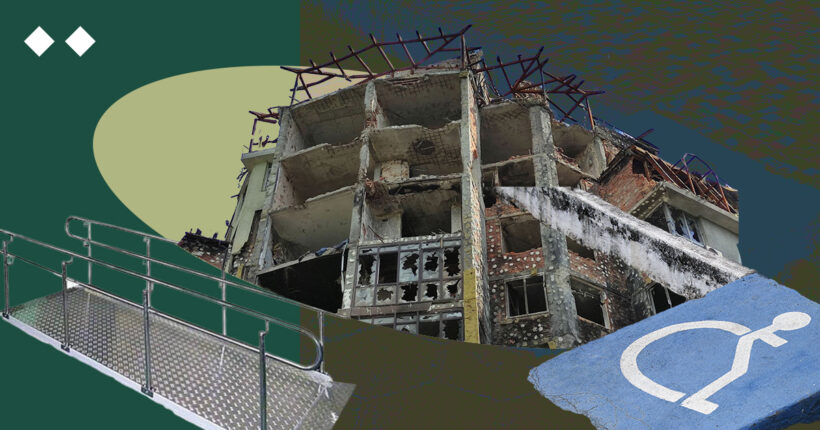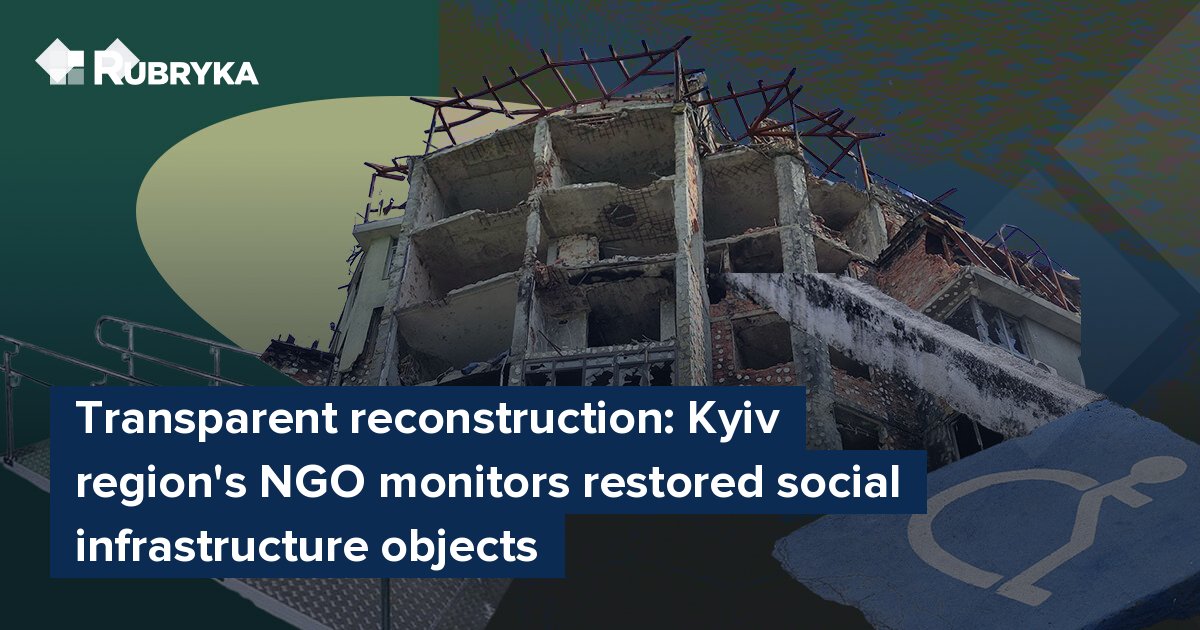
What is the problem?
After the battles in the Kyiv region, Irpin became one of the most destroyed of the liberated cities. According to the Kyiv School of Economics, the Russians destroyed about 48% of the entire housing stock of the city and 53% of the social infrastructure.
The restoration of the city was undertaken as soon as it was liberated. Local and central authorities, international funds, and partner countries joined the processes. Irpin was rebuilt with joint efforts and at different levels — from the replacement of a few windows to the complete restoration of a kindergarten or school.
"In 2022, Irpin had to be urgently rebuilt. The task was to return people to the city. But everything was rebuilt quite chaotically in reality. There was no time for planned procedures or tender purchases," says Olena Sukhobrus, head of the monitoring group.
Such haste, although justified, could still have a negative impact on the quality of reconstruction. So now, when more than two years have passed since the complete liberation of Irpen, it is necessary to look at the already rebuilt objects, analyze the mistakes of rapid reconstruction and understand how to correct them.
What is the solution?
The non-governmental organization Brave Irpin decided to check the quality of the reconstruction of their native city. Thus, with the financial support of the European Union and in cooperation with the Institute of Economic Research and Political Consultation (IED), the project "Transparent reconstruction: monitoring of the reconstruction of social infrastructure in the Irpin community" started on March 1, 2024.
In the first monitoring wave, the team checked the reconstruction quality of 12 facilities, including two dispensaries, six kindergartens, and four schools. The main inspection criteria were transparency, energy efficiency, barrier-free accessibility, and comprehensiveness.
"For example, based on the monitoring results, we realized that everyone seems to understand the need for transparency, energy efficiency, and barrier-free access. But in practice, they cannot ensure this. As a result, we see a ramp with a huge inclination angle, on which it is impossible to enter the school," explains Sukhobrus.

Visit of the EU delegation to the office of the NGO Brave Irpin. Photo: NGO Brave Irpin
How does it work?
Transparency
This is not only about the absence and prevention of corruption but also about the opportunity for citizens to participate in the discussion of reconstruction projects. The monitoring results showed that, in 2022, the damaged facilities were rebuilt without considering public opinion, but Suhobrus says there is an objective justification for this.
"We checked the objects that were being rebuilt as early as 2022. Then, when people had not yet returned to Irpin, some kindergartens were restored for children whose parents came to rebuild the city. That is, there was no discussion because there was no one to discuss it with," she says.
At the same time, the team monitors the transparency of the government's actions and issues related to the community's access to documentation and its timely publication on the city council's website. Their absence turned out to be a frequent violation.
Sukhobrus says that detecting an error is not enough; therefore, within the project's scope, the team has also engaged in educational activities. Specialists explained to community residents that information about reconstruction should be publicly available, and they have the right to influence and control it.
So far, the project executors (Brave Irpin — ed.) state that not all projects have publicized project and estimate documentation in a machine-readable format or at all. Also, a frequent characteristic of such purchases are overpriced prices for a number of materials. "That is why it is important to ensure at the legislative level that the publication of project and estimate documentation (PED) is mandatory," says Oleksandra Betlii, the leading scientific coordinator of IER projects.
Energy efficiency
Before checking this reconstruction criterion, the monitoring team attended special webinars. The acquired knowledge was used during in-depth interviews with people involved in the reconstruction. The quality of the used building materials was also checked.
The head of the monitoring group says that, in general, the energy efficiency check should be done during the construction work. Then, there is an opportunity, for example, to cut out a piece of the wall and check not the numbers in the document but the actual thickness of the insulation. But no one will allow this after the repair is finished, at least because there will be no funding for the restoration of the wall.
According to Sukhobrus, one of the most common mistakes that leads to large heat losses is the loose covering of the facade of the building with insulation. Builders often leave several tens of centimeters of bare wall between the ground and insulation. And this is exactly the case when a seemingly small flaw significantly worsens the quality of the reconstruction.
In addition to insulation, the team also checked the quality of the windows. Particular attention was paid to the presence of mold or fungus. If there are any, then the windows are either of poor quality or installed incorrectly, which destroys the building's energy efficiency. Hot water pipes were also checked—defects in their insulation lead to a decrease in energy efficiency.
During the monitoring process, the team added another item to the list of criteria—energy independence. This was due to Russian attacks on the energy system, which led to aggravation of electricity problems. It turned out that Irpin coped much better with energy independence than with energy efficiency. For example, renovated dispensaries are equipped with solar panels, batteries, and generators. Most schools and kindergartens monitored by the team also have the latter.
Given the importance of energy independence, the Green Deal adopted by the EU, and Ukraine's path to EU membership, it is extremely important to ensure the energy efficiency of rebuilt facilities. That is why it is necessary to consider these important accents during reconstruction. "Although building in compliance with energy efficiency criteria may be more expensive, maintaining such facilities will be cheaper," Betlii says.

Outpatient clinic No. 3 has solar panels installed on the roof.

Outpatient clinic No. 3 has solar panels installed on the roof.
Accessibility
The project team checked this criterion together with Vitalii Pcholkin, head of the non-governmental organization All-Ukrainian Association of Persons with Disabilities Active Rehabilitation Group. He moves around in a wheelchair so he can assess the compliance of restored buildings with accessibility and barrier-free principles in practice.

The team that checked the facilities for barrier-free accessibility, with Vitalii Pcholkin, head of the NGO All-Ukrainian Association of Persons with Disabilities Active Rehabilitation Group. Photo: Brave Irpin
The monitoring showed that most of the restored objects are not completely barrier-free. Sukhobrus explains this by the fact that people do not understand what a barrier-free environment should be like. The most common mistake is the angle of the ramp being too steep. A seemingly invisible few degrees make it impossible for a person in a wheelchair to access the necessary facility without help.
Some believe that instead of setting up the ramp properly, it is enough to install a staff call button so that an employee will help the visitor up. But if a person needs outside help to get into the building, such a solution is no longer inclusive. Also, handrails are often installed at the wrong height, so it becomes more difficult to use them. Another problem is the lack of protection against precipitation.
How can such mistakes be avoided? First, it is necessary to understand what a barrier-free environment is and how to arrange it correctly. Such criteria should be established at the design stage. Then, there won't be the need to look for additional funds to correct errors or ignore the inconveniences that people face.
Instead, the problem that really needs a big solution is the lack of access to shelters for people with disabilities. Most of them are located in basements, so it is impossible to build a ramp to them. In such cases, it is possible to equip an additional entrance to the shelter, which will allow people in wheelchairs to descend.
"Reconstructed objects must provide accessibility for everyone, without restrictions, so barrier-free acessibility is absolutely necessary. Today, the number of people with disabilities is increasing, for whom it is important to be integrated into society and to have access to education, health care, and administrative services. Even accessibility in schools is now about integration since participation in parenting is important for people with disabilities," concludes Betlii.
Comprehensiveness
Comprehensiveness is a criterion that unites all of the above. A school cannot be considered barrier-free if there is a perfect ramp at the entrance, but the way to it is through pits and high curbs. In the same way, one cannot talk about energy efficiency if the pipes are insulated only in the basement of the dispensary, and after five meters they simply lie on the ground.
This criterion can also be applied to the reconstruction in general. Restoration can be of high quality only if it is comprehensive. Spot solutions will not make Ukrainian cities energy-efficient or barrier-free, emphasizes Sukhobrus.
What's next?
Betlii says that this project is about monitoring at different levels. And that the creation of tools for its provision will contribute to increasing the efficiency of using funds for reconstruction.
"Monitoring allows us to develop solutions that we offer, in particular to the Ministry of Reconstruction, to increase the efficiency and accountability of reconstruction," says Betlii. She emphasizes the importance of ensuring the sustainability of such projects and the dissemination of their results in other communities' practices.
In addition, the Brave Irpin team not only identified the mistakes made during the reconstruction but also explained to the people involved in the reconstruction what each of the monitoring criteria entails in practice. That is, for example, how exactly to make the space barrier-free and what energy efficiency depends on.
Therefore, improvements await thanks to the monitoring of 12 objects with which Brave Irpin worked. The Brave Irpin team is already preparing an advocacy campaign with the authorities and a communication campaign with the local community to openly discuss the necessary changes and attract public opinion.
The team does not plan to stop there. Brave Irpin is preparing to start monitoring purchases of already implemented reconstruction objects — such a list has already been compiled.
The EU supports such projects, which directly affect the lives of the community and citizens. It is important to scale them to other regions of Ukraine that will have to be rebuilt in the future. Mykhailyna Skoryk-Shkarivska, director of the NGO Brave Irpin and the official of the Irpin city council, emphasizes: "In the process of monitoring the reconstruction, we saw many typical mistakes that can be corrected if we focus not only on building regulations but also on the people who will use them. Thanks to such projects supported by the EU, we can develop recommendations for municipalities and businesses on how to make reconstruction in communities truly people-centric. And this has great potential for non-governmental organizations."
Find out more about the European Union's support for civil society and independent media in Ukraine at the link.









